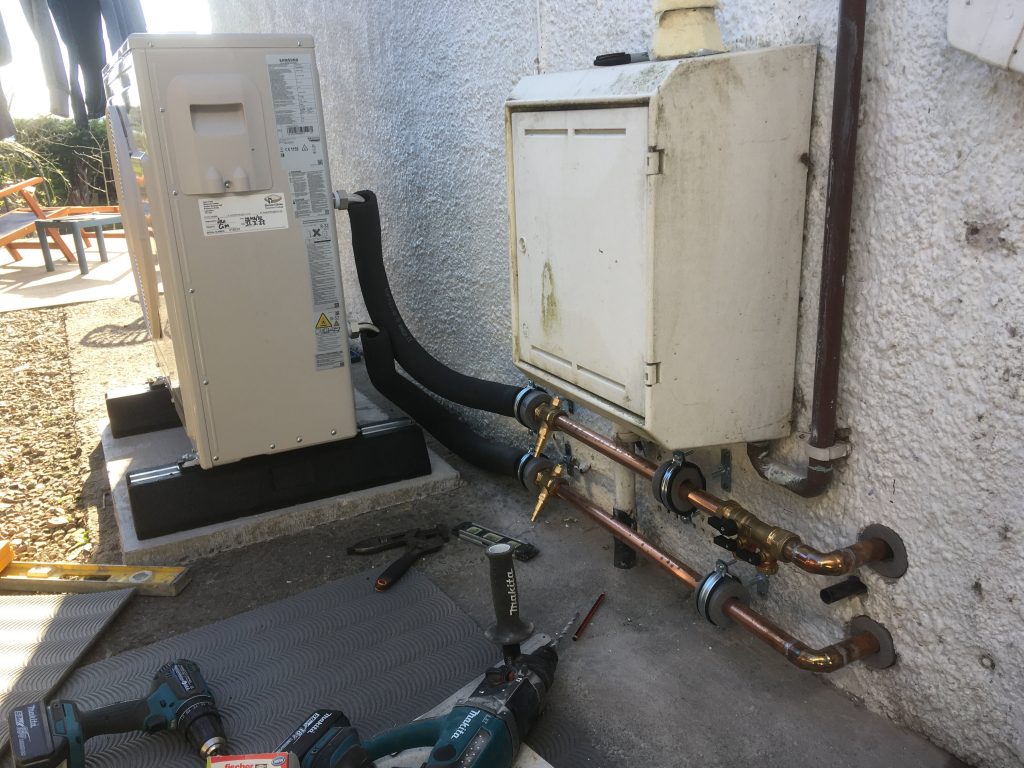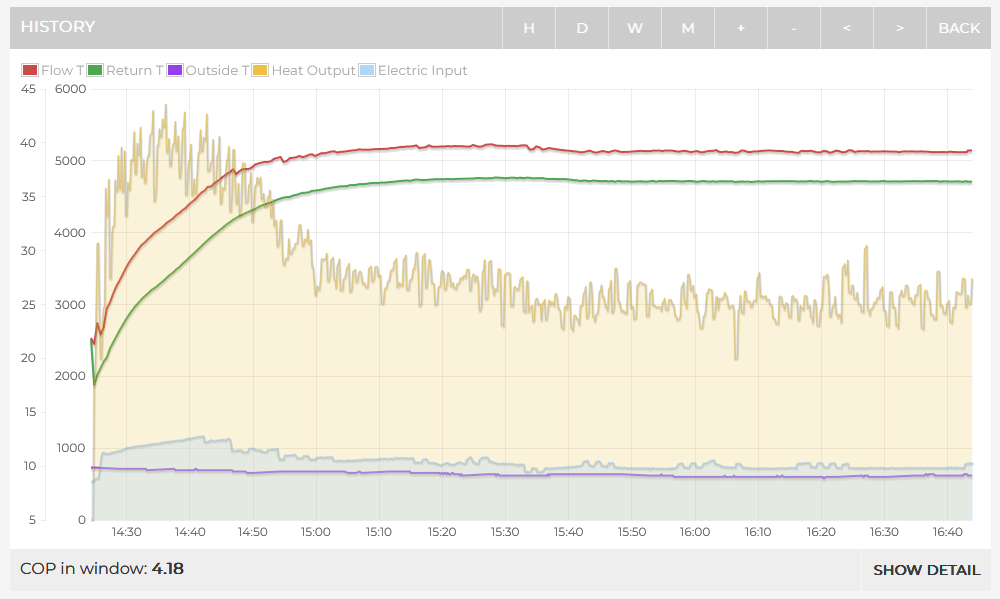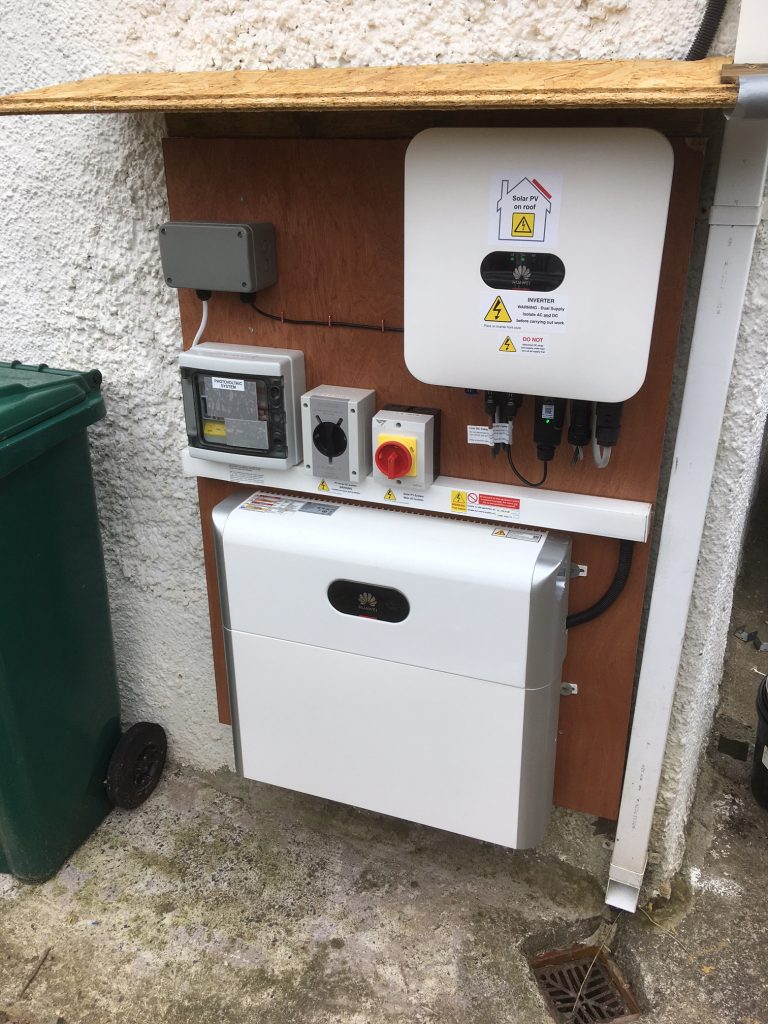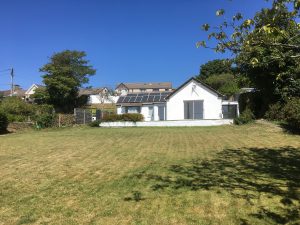Samsung 5kW R32 Monobloc Gen 6 ASHP
In August 2022, we moved into our new two-bedroom house in Pembrokeshire. The bungalow, originally built sometime in the 1800s, was of solid stone construction. It had been extended in the 1970s with a new kitchen and front room featuring double breeze block construction with loose-fill insulation. The EPC was an optimistic C, but it did have 2.66 kW of solar panels on the highest FIT tariff.
I had installed a 5 kW Mitsubishi Ecodan ASHP in my previous house, a self-build from 2012, and wanted to use a heat pump again in this one. This property currently had a quite nice, newish gas combi boiler, but I knew I could reuse it in a rental property I owned.
I had been happy with the Mitsubishi and considered purchasing one again, but was tempted by the cheaper, newer, higher-temperature Samsung Gen 6, which I had heard good things about and seen that the controller was easier to set up. It also had some interesting communication options via Modbus.
I considered applying for the government grant, but for various reasons, decided to install it myself. It would be cheaper that way, and I was confident that I could do a better job than many of the installs I saw complaints about.
In preparation for the heat pump, I beefed up my loft insulation and ran my gas boiler at a low temperature to see where I needed radiator upgrades. I was able to shuffle radiators about to smaller bedrooms, purchasing only two very large radiators for the living areas. I also fitted a Mixergy hot water cylinder and MyEnergi Eddi solar diverter to enable us to have hot water once the gas combi was removed.
In February 2023, I bit the bullet and ordered my Samsung 5kw R32 Monobloc Gen 6 heat pump from The Heat Pump Warehouse. It arrived as promised, and I set about installing it with the help of some YouTube videos. In my previous house, I was frustrated that I could not monitor how my heat pump was performing, so I decided to stump up for an OpenEnergyMonitor system that would do the job.
Installation went relatively smoothly until it was time to switch it on. At this point, an error code popped up. After much frustration and fault-finding on a Sunday, I found the problem. The fan hadn't been plugged into the main circuit board. Needless to say, I was a bit miffed about this and later discovered that the heat pump had, in fact, been supplied by Joule, who denied all responsibility for the fault and even went so far as to accuse me of sabotaging it myself.

I encountered some other issues along the way, and these are described fully in my blog, The Greening of Rose Cottage, for those interested. The Samsung controller was used as the only thermostat for the system.
Once the heat pump was up and running, I set about adjusting the weather compensation settings to give us the appropriate heating temperature. We prefer 22C in the living rooms and cooler in the bedrooms. All thermostatic radiator valves were opened to their maximum, and the manual radiator valves were used to adjust flow. Further adjustments were made as the outside temperatures got colder later in the year. We tend only to heat the house during daytime hours.
The heat pump performed well, with heating SCOPs between 4.65 in September to 3.97 in December. After purchasing an electric vehicle and moving to the Intelligent Octopus tariff, I made the decision just to heat the water cylinder via the immersion heater at night for 7.5p/kWh and not to purchase a heat exchanger to enable it to be heated via the heat pump.

To complement the heat pump, I had an additional 4.65 kW of solar panels fitted, along with a 5kWh battery. This helps keep the electricity costs down greatly, and so far, bills have been lower than they would have been had we still been using gas. I expect to see a significant income from export in the summer months to help offset the costs of the improvements.

House-2 bed partial stone bungalow, 5kW Samsung Gen 6 ASHP (Self install)
6.9 kWp of PV
5kWh DC coupled battery
Blog: https://thegreeningofrosecottage.weebly.com/
Heatpump Stats: http://heatpumpmonitor.org/system/view?id=60
I'm super impressed with your initiative to self-install your system, and shocked in equal measure by Joule's sabotage accusation. That's really crazy. But kudos to you for seeing it through and getting it up and running.
Get a copy of The Ultimate Guide to Heat Pumps
Subscribe and follow our YouTube channel!
Well done, impressed wish i could have done my own, spent years with the loans/grants fiasco never got a penny. I used an MCS, RECC, approved company, in 2014 still solving issues, had another Napit Inspector this month!!
As was I Mars. TBH the whole telephone conversation was bizarre, I was expecting at least an apology but got a full scale nuclear attack!
I have used a thin layer of an insulating lime render on one bedroom wall, more for damp control really and it is expensive. I aim to frame and insulate another wall with insulated plasterboards.
I'm curious how your measured SCOP compares to the "generated" and "consumed" energy totals reported by the Samsung itself? I have an oversized Gen6 Samsung 8.5kW in a super-insulated house (peak heat demand 3.3kW, which delivers an average generated / consumed ratio (SCOP?) of 2.75. This includes hot water use with legionella killing switched on. Very frustrating. I know it's crazy to have such a big HP, it came before the insulation before I knew the word "heatgeek", sized on the old EPC, and cycles like crazy! One cheer for the installer.
Sorry for the delayed reply, there was no notification of your question and I just happened across it. The Samsung COP is vastly less than my openenergy monitor COP. For example on the 27th Samsung reported 4.2 whereas OEM reported 5.2. Given the fact I am using a certified heat meter, I am confident it is Samsung that is wrong.
House-2 bed partial stone bungalow, 5kW Samsung Gen 6 ASHP (Self install)
6.9 kWp of PV
5kWh DC coupled battery
Blog: https://thegreeningofrosecottage.weebly.com/
Heatpump Stats: http://heatpumpmonitor.org/system/view?id=60
Posted by: @bontwoodySorry for the delayed reply, there was no notification of your question and I just happened across it. The Samsung COP is vastly less than my openenergy monitor COP. For example on the 27th Samsung reported 4.2 whereas OEM reported 5.2. Given the fact I am using a certified heat meter, I am confident it is Samsung that is wrong.
@bontwoody I don't have a heat meter, but I do have a MID-approved electricity meter measuring the consumption of the heat pump (heat pump only, so excludes MIM controller and pumps), and the Samsung reported figures are more than the MID meter, even allowing for pump usage, measured at 35W each (two pumps, 70W combined). I have to rely on the Samsung figures for generation to calculate (S)COP as that's all I have, but at least I know my electricity usage is low.
Samsung 12kW gen6 ASHP with 50L volumiser and all new large radiators. 7.2kWp solar (south facing), Tesla PW3 (13.5kW)
Solar generation completely offsets ASHP usage annually. We no longer burn ~1600L of kerosene annually.
I'm curious how your measured SCOP compares to the "generated" and "consumed" energy totals reported by the Samsung itself? I have an oversized Gen6 Samsung 8.5kW in a super-insulated house (peak heat demand 3.3kW, which delivers an average generated / consumed ratio (SCOP?) of 2.75. This includes hot water use with legionella killing switched on. Very frustrating. I know it's crazy to have such a big HP, it came before the insulation before I knew the word "heatgeek", sized on the old EPC, and cycles like crazy! One cheer for the installer.
Hi @Nick Owens, welcome to the forum.
My Samsung is the 12kW (gen6) model, and last winter my heat loss was just over 4kW on the coldest day... so welcome to the over-sized ASHP club!
I get reasonably good COPs by trying to extend run times using batch heating. You are never going to be able to run continuously low and slow, and the cycling will kill efficiency. I use an external room thermostat (FSV #2091/2) and run in "continuously on" mode (FSV 2093 = 1) to prevent the heat pump cycling, and then just try to extend run times. This does result in significantly more temperature fluctuation but we do achieve good COPs (currently over 5 on a heating run). At the moment we may run the heating for around 30-45mins and then turn off and allow the house to cool by 1-2C before another short batch of heating. We run with a flow temp of 32-33C at the moment, which is the minimum we can achieve in order for our radiators to be able to dissipate the 4kW plus of heat that is the minimum output of my ASHP.
So we can potentially just about achieve continuous running once the outside temp hits 0C, but as soon as the temp rising above freezing, we are cycling or switching off (and we only seek to heat to 20C)
Samsung 12kW gen6 ASHP with 50L volumiser and all new large radiators. 7.2kWp solar (south facing), Tesla PW3 (13.5kW)
Solar generation completely offsets ASHP usage annually. We no longer burn ~1600L of kerosene annually.
-
British Gas Heat Pump Installation Complaint
2 months ago
-
Heating Turned Off but Radiators Still Warm
3 months ago
-
Samsung Heat pump with Yonos Pico circulating pump running all the time
3 months ago
-
Avoid the Heat Pump Villain: Why Low-Loss Headers and Buffers Can Sabotage Your Heat Pump's Efficiency
4 months ago
-
Vaillant AroTherm Plus 7kW
7 months ago
- 26 Forums
- 2,417 Topics
- 54.8 K Posts
- 178 Online
- 6,096 Members
Join Us!
Worth Watching
Latest Posts
-
RE: Octopus Cosy 12 Heat Pump Regret: Incredibly Loud, Poor Heating & Constant Hum - Help!
So, after much anguish, and even visiting the neighbour...
By razz , 53 minutes ago
-
MLCP (Multi-Layer Composite Pipe) for ASHP
@editor nope. The info you reported was sufficient for ...
By iotum , 3 hours ago
-
RE: Advice for a novice on Mitsubishi Ecodan 6kW
@robs Quick response while I'm in stationary traffic le...
By Sheriff Fatman , 3 hours ago
-
RE: Setback savings - fact or fiction?
Maths looks right to me, my only question about this ca...
By JamesPa , 4 hours ago
-
RE: Ideal HP290 14kW ASHP - how to optimise
@jamespa I wasn’t offended at all. You are very knowled...
By Davesoa , 4 hours ago
-
RE: Experience - New Build / Complete New Heating System
@vincro I would be surprised if it is much above 5 to 6...
By ASHP-BOBBA , 4 hours ago
-
RE: Recommended home battery inverters + regulatory matters - help requested
Yes, certainly not enough could have been tested in any...
By Batpred , 5 hours ago
-
RE: Post-Traumatic Heat Pump Stress Disorder
Yes bang on and maybe I can illustrate that by way of e...
By iotum , 7 hours ago
-
-

RE: Replacing my 18 month old Hitachi Yutaki ASHP
A big thank you to @jamespa for all his efforts online ...
By trebor12345 , 10 hours ago
-

RE: GSHP WOES! Midland based engineer recommendations?
@editor It is indeed for servicing. My current service ...
By Morgan , 10 hours ago
-
RE: Sunsynk Whole House Backup Issue
Hi @lostandconfused , I agree that topic/thread is the ...
By Batpred , 11 hours ago
-
RE: Speedcomfort radiator fans
In case it helps Andrew Kuhne on openenergy monitor has...
By JamesPa , 11 hours ago
-

Things have gone quiet with you @drei. Any updates?
By Mars , 14 hours ago
-

RE: Passiv Smart Thermostat - Help & Forum Support
Thanks @tim441. Interesting timing, as Passiv are a cur...
By Mars , 16 hours ago
-
Hi everyone, I have a two year old Marlec Solar iBoos...
By Tallmarc , 19 hours ago
-
RE: Please help with the settings ecodan
Are you trying to address any particular performance is...
By Sheriff Fatman , 1 day ago
-
RE: Solis inverters S6-EH1P: pros and cons and battery options
🤣 Well, I never managed to get the HA solis "...
By Batpred , 1 day ago







